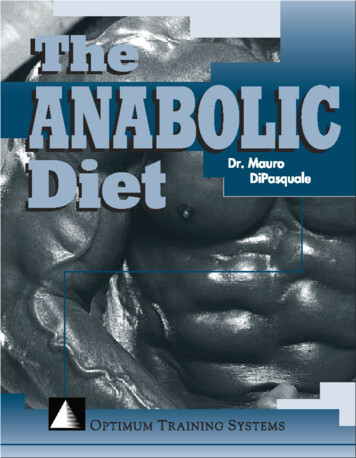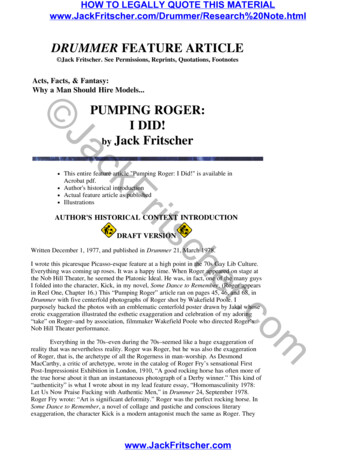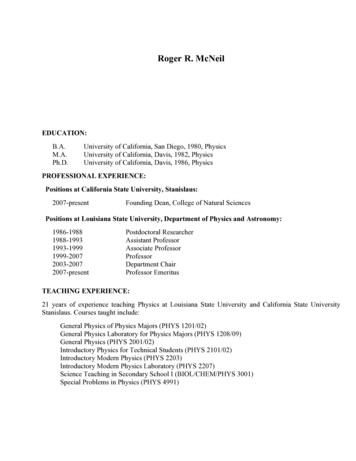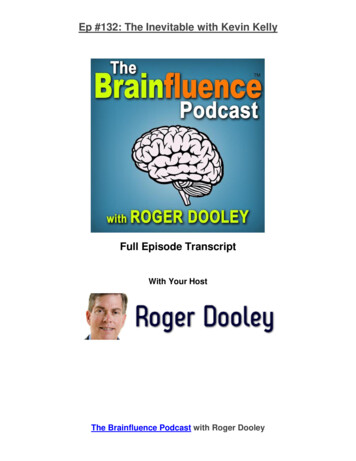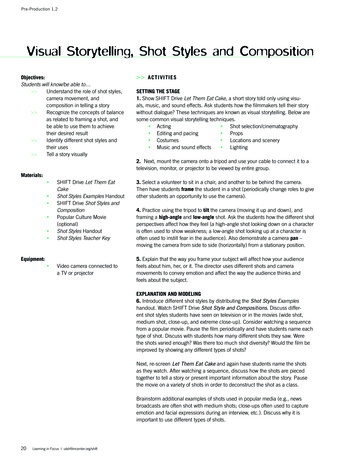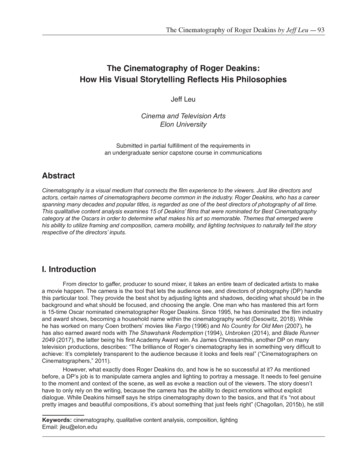
Transcription
The Cinematography of Roger Deakins by Jeff Leu — 93The Cinematography of Roger Deakins:How His Visual Storytelling Reflects His PhilosophiesJeff LeuCinema and Television ArtsElon UniversitySubmitted in partial fulfillment of the requirements inan undergraduate senior capstone course in communicationsAbstractCinematography is a visual medium that connects the film experience to the viewers. Just like directors andactors, certain names of cinematographers become common in the industry. Roger Deakins, who has a careerspanning many decades and popular titles, is regarded as one of the best directors of photography of all time.This qualitative content analysis examines 15 of Deakins’ films that were nominated for Best Cinematographycategory at the Oscars in order to determine what makes his art so memorable. Themes that emerged werehis ability to utilize framing and composition, camera mobility, and lighting techniques to naturally tell the storyrespective of the directors’ inputs.I. IntroductionFrom director to gaffer, producer to sound mixer, it takes an entire team of dedicated artists to makea movie happen. The camera is the tool that lets the audience see, and directors of photography (DP) handlethis particular tool. They provide the best shot by adjusting lights and shadows, deciding what should be in thebackground and what should be focused, and choosing the angle. One man who has mastered this art formis 15-time Oscar nominated cinematographer Roger Deakins. Since 1995, he has dominated the film industryand award shows, becoming a household name within the cinematography world (Desowitz, 2018). Whilehe has worked on many Coen brothers’ movies like Fargo (1996) and No Country for Old Men (2007), hehas also earned award nods with The Shawshank Redemption (1994), Unbroken (2014), and Blade Runner2049 (2017), the latter being his first Academy Award win. As James Chressanthis, another DP on manytelevision productions, describes: “The brilliance of Roger’s cinematography lies in something very difficult toachieve: It’s completely transparent to the audience because it looks and feels real” (“Cinematographers onCinematographers,” 2011).However, what exactly does Roger Deakins do, and how is he so successful at it? As mentionedbefore, a DP’s job is to manipulate camera angles and lighting to portray a message. It needs to feel genuineto the moment and context of the scene, as well as evoke a reaction out of the viewers. The story doesn’thave to only rely on the writing, because the camera has the ability to depict emotions without explicitdialogue. While Deakins himself says he strips cinematography down to the basics, and that it’s “not aboutpretty images and beautiful compositions, it’s about something that just feels right” (Chagollan, 2015b), he stillKeywords: cinematography, qualitative content analysis, composition, lightingEmail: jleu@elon.edu
94 — Elon Journal of Undergraduate Research in Communications, Vol. 11, No. 1 Spring 2020is widely regarded for his artistic craft. He has masterfully kept a consistent, effective theme throughout hisworks to become one of the best in the business.The goal of this research is to understand how Roger Deakins uses a range of techniques fromcamera movements and angles, “mise en scène,” and balance of light and shadows to fully display a varietyof emotions in his shots. All these aspects of cinematography naturally arouse the viewer’s brain, bringing thedirector’s vision to life.II. Literature ReviewThis section examines the techniques of cinematography, highlighting the significance and meaningbehind certain choices. It also explains the relationship between directors and cinematographers, and howDeakins has aligned his work to the directors’ visions.Fundamentals of CinematographyFilmmaking is a multidimensional medium. There are so many pieces that come together to createa movie, and the camera should not be ignored. It is not only just a tool to capture footage, but another wayto tell a story. It is the lens of the viewers peering into a scenario like a fly on the wall. When it comes downcinematic elements involving the camera, there are three characteristics: mise en scène, movement, andlighting.Mise en scène, which literally translates to “staging,” is the term for what appears in the frame atany moment. That includes things like actors, props, and costumes. The camera’s specific role would bethe composition, such as the angle and type of shot. An angle above the subject shows a much differentpower dynamic than an angle below the subject, same as a wide lens shot feeling much less claustrophobicthan a telephoto lens shot (Block, 2008). These all affect the visual arrangement on screen, which impliescertain relationships between the elements (Mamer, 2003). Selecting the frame is so vital to filmmaking, asfilmmakers must direct the audience’s attention (Brown, 2016). It is the most obvious, yet also most subtle,form of persuasion.A film is never purely static. Camera movements add dynamics to a shot and keep it from gettingstale. However, it should not just move for the sake of moving; it must have a purpose. Following a characterthrough trucks and dolly allows a moment of empathy; pans and tilts expose information that were previouslyhidden (Block, 2008). These elements of filming confirm a sense of natural reality (Bacher, 1978). Stagingof the action in the frame, especially in relation with the camera, makes the cameraman “catch” what is“happening” realistically (Bacher, 1978). This adds another layer within the third dimension, instead of a flatprofile that static shots typically demonstrate.Lighting’s sole purpose is not to just fill a space and help the eye see, it also can be used in a wayto illustrate a tone. Harsh lighting setups that emphasize straight lines and edges on a subject provide anunsettling feeling, while soft lighting that nicely envelopes the subject seems less intense and more angelic(Block, 2008). And the focus should not be just light itself, but the absence of light. Shadows are equallysignificant since they play a big role in setting the scene, and it looks natural. The painting of light within aframe goes a long way in determining the general character of the image, and what message the filmmakerswant to put out for those watching (Mamer, 2003).Cinematography is not simply something anyone can just pick up a camera and do. It requires lots ofplanning and careful execution. Motivation should always be in hindsight, and present in a way that includesall required story elements (Lucas, 2011). It can be artistic, contributing a mood or sense of pace, but it mustfit. In other words, is it good for the story? The director and DP must negotiate that.Directors’ PhilosophiesIn terms of creative decisions, the director is essentially in charge, though in collaboration with all thedepartment heads. When a DP maintains a good relationship with the director, the DP is often invited back towork on another project. Such is the case for British director Sam Mendes, who has worked with Deakins onfive separate occasions, including the James Bond film Skyfall (2012) and the one-take Best Cinematographywinning war film 1917 (2019). Denis Villeneuve, a French director who has burst onto the American cinema
The Cinematography of Roger Deakins by Jeff Leu — 95scene in recent years, is another frequent collaborator, the two working on Prisoners (2013), Sicario (2015),and his other Best Cinematography winner Blade Runner 2049. However, Deakins’ go-to team seems to beJoel Coen and Ethan Coen, better known as the Coen brothers. The directors with eccentric tastes on classicgenres have worked with the cinematographer on 12 separate films, starting with Barton Fink (1991) and themore recent Hail, Caesar! (2016). All these directors have different styles, yet Roger Deakins has managed tofulfill their visions. In the end, it came down to what he does best: keeping it simple.Simplicity is a philosophy for Sam Mendes. Instead of crazy blockbuster action or over- the-topspecial effects, he opts for studying the psyche of characters (Sam Mendes—Behind the Camera, 2016).Jarhead (2005) was the first time Sam Mendes and Deakins worked together as a pair. The story putsan existential spin on a Marine’s experiences during the Gulf War (Thomson, 2005). Deakins describedhow Mendes emphasized that “it wasn’t a conventional war story it’s really about these kids being takensomewhere they don’t understand, to fight a war they don’t understand” (Thomson, 2005). RevolutionaryRoad is about an unhappy marriage in suburban Connecticut. The key, explained by Mendes, lay in stayingclose to the main characters and having the cinematography reflect that (Bosley, 2009). Roger Deakins wasall about reverting to basic rules of camerawork, and a matter of keeping it easy to follow.For Denis Villeneuve, the naturalist look is the driving force, although still keeping the route ofsimplicity. During Prisoners, a movie about a man trying to find his daughter’s kidnapper, they shot duringThanksgiving, using the darker light of fall to convey a more depressing tone that replicated the storyline(Chagollan, 2015a). With Sicario, a story about a strike team fighting back against Mexican drug lords, it wasthe other end of the spectrum. They shot in the Chihuahua Desert in order to capture the harsh, brutal lightingof the sun (Benjamin, 2015). To maintain the state of realism, the pair researched photographs and locationswhile constantly updating a storyboard until production (Benjamin, 2015).The Coen brothers’ oeuvre is a bit of a wild card. Their films range from a variety of genres, thoughalways in the realm of absurd grittiness, quirky humor, and insightful characters. O Brother, Where Art Thou?(2000) blends comic hijinks and social commentary (Conard, 2012). A film about a trio of men in pursuitof freedom and treasure, it is a modern satire loosely based on Homer’s epic poem in The Odyssey. Thestyle evoked old movies and the Depression, utilizing faded earth colors for a full effect (Toscano, 2009). NoCountry for Old Men, on the other hand, is an outlier Coen brothers work. It is not unusual for the directors totake on dark themes, but previous films always had a level of meta-irony, in which the stories were meant tobe consumed as a detached reality (Conard, 2012). The plot centers around a cowboy who finds a briefcasefull of cash, an escaped sociopathic killer trying to retrieve said briefcase, and a sheriff trying to stop theviolence. Deakins decided to play with silhouettes and shadows much more, as if the harshness of the realworld was dawning upon everyone. As the DP says, “That is what great filmmaking is – an exploration ofourselves” (King et al., 2009). The camerawork modeled what each character represented in the UnitedStates, and what the code of human ethics have become (King et al., 2009).Deakins’ CraftRoger Deakins does not own a style, rather he alters his style to suit the project that he’s on (TheFilmmaker’s View, 2017). His craft is purely based upon the combination of basic cinematography rulesand what the director needs. Even after nearly 40 years in the industry, Deakins feels like a newcomer onevery set, noting that “any way a film looks is a product of prep on that look, on that film, and how that sort ofdeveloped.”(The Filmmaker’s View, 2017). However, what sets him apart from other cinematographers is hisinstinctual personality and hands-on methodology.Starting out in documentaries, Deakins learned to think quickly and take a simple approach to hiscraft. It taught him to have a sixth sense in what is about to happen and what belongs in the frame, where oneshould position the camera to interpret the scene while working quickly and instinctively (Chagollan, 2015b).That is exactly why, even though the technicality of his shots is elementary, his mind and vision creates theworld to fill the space and make it that much more special. He still spends effort and time to perfect a sceneso that it leaves a lasting impression (Roger Deakins: Breaking Down the Master Cinematographer, 2018).Roger Deakins is also the type of DP to operate the camera. In Hollywood, the cinematographersometimes never touches the camera, but leads the visual department in where to set up and how to capturethe shot (Kilhefner, 2018). He does not believe in this method, since it can impede on his creative process.“There’s so much about the movement of the camera and the composition, you want to be open to the little
96 — Elon Journal of Undergraduate Research in Communications, Vol. 11, No. 1 Spring 2020things that happen on a set,” Deakins explains. “You can’t be if you’ve got to communicate with an operator”(The Filmmaker’s View, 2017).In the end, Roger Deakins adds complexion to already known fundamentals. He bases his framingand composition on instinct, then adds on touches of lighting, mise en scène, and movement for artisticpurposes. Hardcore film nerds and casual moviegoers alike can relate to his shots. In turn, his name remainspresent when awards season rolls around.III. MethodsThis study is a qualitative content analysis of the 15 films for which Roger Deakins received an Oscarnomination for Best Cinematography. These films were chosen for nomination because of their exceptionalcamerawork and critical acclaim, making them a logical way to study his technique. Each movie wasexamined by its cinematography, specifically how his craft fit the feel of each piece while maintaining certainvisual elements and themes to portray a shot. In order to do so, the basic fundamentals of cinematographywere considered, such as mise en scène, camera movement, and lighting. The directors’ inputs were alsostudied to better understand Deakins’ justification of how to shoot the scene. Table 1 provides the name of themovie, the year it was released, and who the director was.Table 1. Movie Title, Year, and DirectorMovieYearDirectorThe Shawshank Redemption1995Frank DarabontFargo1996Joel Coen, Ethan CoenKundun1997Martin ScorseseO Brother, Where Art Thou?2000Joel Coen, Ethan CoenThe Man Who Wasn’t There2001Joel Coen, Ethan CoenNo Country for Old Men2007Joel Coen, Ethan CoenThe Assassination of Jesse James 2007by the Coward Robert FordAndrew DominikThe Reader2008Stephen DaldryTrue Grit2010Joel Coen, Ethan CoenSkyfall2012Sam MendesPrisoners2013Denis VilleneuveUnbroken2014Angelina JolieSicario2015Denis VilleneuveBlade Runner 20492017Denis Villeneuve19172019Sam MendesIt is important to note that qualitative research is not generalizable, but instead provides insight intohow his art is so memorable to critics and audiences worldwide.Research QuestionsThe following research revolves around these questions:RQ1: What are some of the recurring themes in how Deakins effectively frames his shots?RQ2: How does the way Deakins shoots reflect his philosophy as a cinematographer?RQ3: How does Deakins craft a film’s visual style in respect to the directors’ inputs?
The Cinematography of Roger Deakins by Jeff Leu — 97IV. FindingsWhile each film varied in genre, mood, and story, the cinematography remained exceptional andpurposeful throughout. Roger Deakins’ choices of shots improve the fundamentals of camerawork yetmanages to maintain a relationship with the directors’ inputs.Mise en ScèneOf the 15 academy nominated films, five are particularly noted for framing and composition. Theseinclude technical aspects such as choice of lens and angles and what they contribute to the story, but itcan also include what’s within the frame like lines, shapes, and spacing. The Reader is about a boy whoseromantic relationship with an older woman ends abruptly. He finds out years later that she is on trial for aNazi war crime. While the story revolves around the setting of the Holocaust, director Stephen Daldry hopedit would not be digested as a Holocaust film, rather about human relationships and consequences (RTInterview, 2009). Therefore, Deakins depicts many of the early scenes with intimacy as audiences witness thegrowing love between the two main characters.Figure 1Roger Deakins aids the audience in understanding the bond between Michael and Hanna by framingthe two together within the confines of the bathtub (see Figure 1). By employing a wider lens and stayingclose to the subjects, the claustrophobic environment feels more intimate, as if they were sharing each other’spersonal space. However, later in the film the framing strays away in distance, and surface division starts toappear.Figure 2
98 — Elon Journal of Undergraduate Research in Communications, Vol. 11, No. 1 Spring 2020Surface division is described as dividing the screen into smaller areas for the visual storytelling ofdisconnect (Block, 2008). In another scene, Michael is recollecting his thoughts upon seeing Hanna againseveral years later (Figure 2). He does not attend any of his law school parties, instead chooses to observefrom a distance. Seeing the different actions in each room shows how Michael does not feel at place in theworld anymore. A similar tactic is used in Deakins’ first Academy win, Blade Runner 2049.Figure 3The visually stunning movie revolves around a Los Angeles police officer on a quest to find a formerblade runner. As depicted in Figure 3, the steel railing and beams separate Officer K from a giant purpleadvertisement, reiterating his disconnect from the technological dystopian society he lives in. While one canargue that a futuristic society offers more traditionally gorgeous shots than a historical period piece, Deakinsapplies similar techniques of cinematography that enhances both narratives, proving his philosophy thatvisuals must aid the story not overarch it.Geometric shapes are subtle and common mise en scène tools for eliciting natural reactions (Block,2008). Kundun, a 1997 film directed by Martin Scorsese, recounts the story of the Dalai Lama’s early life.As seen in Figure 4, the circular shape of the telescope and human head instinctively places a sense ofnaturalism in the brain (Renée, 2016). Since the Dalai Lama’s story is about his journey to spiritualism,Deakins opted for rounder mise en scène. Viewers are meant to feel at ease and unthreatened as the storymoves forward, mirroring the protagonist’s arc. In this film, Scorsese stepped away from his usual violent mobdramas and into a story characterized by serenity. He wanted the audience to watch an experience ratherthan a spectacle (Suton, 2019). With the help of Deakins, a color and shape palette was created amongbackdrops of luscious scenery. Deakins said the movie was “very much a poem, rather than a traditionalnarrative film, more of a mood piece than anything else” (Suton, 2019).Figure 4
The Cinematography of Roger Deakins by Jeff Leu — 99Deakins’ work in Coen brothers movies demonstrates his varied approach. As for Fargo, the Coenbrothers were fresh off of the very stylized Hudsucker Proxy. The directors wanted to contrast that with astark style, mirroring the dead, wintry times of North Dakota. Deakins chose to employ dull mise en scènewith few landscapes, in which the brothers noted became another form of stylization itself (Burwell, 2017).Following up with O Brother, Where Art Thou?, the brothers returned to their stylish roots. Scheduled to shootin the summer, Deakins had to find ways to desaturate the greens for the look of old, hand-tinted postcardsthat the directors favored (Escaping From Chains, p. 1, n.d.). “The film was also the Coen brothers’ firstexperience shooting in a widescreen format, which Deakins had suggested because of the importance of thelandscapes and epic nature of the story” (Escaping From Chains, p. 2, n.d.). By stepping back and not lettinghis cinematic ego take over his mindset, Deakins allows his storyteller brain to activate and produce the bestfilm possible.Fargo often opts for straight geometric shapes such as squares. A film about a man’s attempt tokidnap his wife for ransom money in order to overcome a struggling, mundane life, the shapes within thecomposition must reflect the plot. The protagonist, Jerry, has financial problems and is trying to invest inthe construction of a parking lot for income. After being turned down by his wealthy father-in-law, he angrilywalks to his car. The blocks of trees and his angled car are all spaced equally in frame as he walks throughthe square crossroads of his tire tracks (Figure 5). These shapes represent manmade stability that is oftenviewed as boring, which is an obstacle the character must overcome (Renée, 2016).Figure 5Another technique Deakins utilizes is lines. Lines indicate a direction for viewers to follow, as thehuman eye is naturally drawn to them (Block, 2008). Figure 6 shows isolation, and a long road to nowhereand uncertainty, a problem the protagonist falls into when conducting his ransom attempt (Figure 6). He doesnot know what is going to happen next as everything spirals out of his control. Deakins effectively uses astraight line, a basic cinematic technique, to further drive the story in a visual manner.Figure 6
100 — Elon Journal of Undergraduate Research in Communications, Vol. 11, No. 1 Spring 2020This contrasts with O Brother, Where Art Thou? where Deakins frames lines to show a long journeyahead. The adventure film centers on three escaped inmates travelling through the south in search fortreasure. With a line splitting the frame in half down the middle, it provides a deep space shot of ruralAmerica, indicating a sense of hope for the characters as they journey through their story (Figure 7).Figure 7Camera MovementThe mobility of camera is often practiced in order to give a feel for reality. It can connect moviegoerswith the characters, contribute points of view, and reveal hidden objects within the frame (Block, 2008). In atense highway sequence in Sicario, the United States task force and Mexican drug cartels draw their guns atone another, with Deakins providing a helicopter shot from above.Figure 8The camera tilts down from a crowded highway of the U.S.-Mexico border to reveal a strike teamapproaching cars with their guns up (Figure 8). This nerve-wracking moment was emphasized by the useof moving aerial footage, because it feels like a bird’s eye view as if it were happening in real time. Duringshooting, New Mexico was in the midst of monsoon season, so Deakins was worried that much of the aerialcinematography would overtake the film due to vast cloud formations. However, he and Villeneuve adaptedwith the unexpected changes to paint the landscape as a threatening, oncoming character (Raya, 2016).Later, within the same scene, the camera operates with more movement, this time from theprotagonist Kate Macer’s point of view. The FBI agent looks around in horror as the opposing forces open fire,then she realizes a man in the sideview mirror about to shoot her (Figure 9). Deakins thrusts the camera intoher viewpoint, as it pans left to right in a panicked manner, mimicking her current mindset. When she sees theman, the audience also sees him in a moment of empathy.
The Cinematography of Roger Deakins by Jeff Leu — 101Figure 9A similar approach can be found in True Grit. In this story about a teenage farm girl trying to find herfather’s killer, the story introduces one of the main characters, a lawman named Rooster Cogburn, throughthe point of view of the young protagonist. She shuffles through the crowd in the courtroom where he is beingtried for shooting and killing criminals instead of detaining them (Figure 10). The slow camera track behindthe back of men’s heads once again pushes the viewers into the character’s eyesight, and they meet Roosteralong with her. Deakins adds, “I have an overall kind of approach to cinematography that it should be assimple and as submissive to the script as possible, because I think so much of it is about the relationshipbetween the camera and the actors” (The Cinematography of True Grit, 2011).Figure 10There are also times when the camera movement can be empathetic without the use of a point ofview. Unbroken, tells the story of Louis Zamperini, an Olympic runner who gets captured during World WarII. There is a scene where he runs the 5,000-meter race in the 1936 Summer Olympics. In the final lap hebegins overtaking the other runners as the camera tracks in front of him, capturing his sweat-beaded intensityand determination. It is not a point of view, yet keeping the camera stationed on him throughout the last lapoffers another touch of connection (Figure 11). After he sets a record for the fastest lap at 56 seconds, theaudience understands his elation as they followed and watched him the entire time. Director Angelina Jolierecounts during preproduction the tendency to include shaky cameras or quick cuts between multiple anglesin the shot list to convey energy, only for Deakins to jokingly laugh and say to not do such “tricksy shots”(Angelina Jolie – Unbroken, 2014).Figure 11
102 — Elon Journal of Undergraduate Research in Communications, Vol. 11, No. 1 Spring 2020The battlefield drama 1917 presented Deakins with a unique challenge: shooting it as if it was onecontinuous shot for nearly two hours. The film tracks two British soldiers as they race through a carnagestrewn landscape to deliver a message that might save 1,600 lives. In the climax of the film, we seeLieutenant Schofield running perpendicular to the first wave of troops, avoiding explosions and other soldiers(Figure 12).Figure 12When director Sam Mendes pitched this idea, the concept of a continuous take had already beendone before. Yet, he wanted to take it a step further by keeping it action packed and consistent to realtime. “It was fundamentally an emotional choice. I wanted to travel every step with these men – to breatheevery breath with them. It needed to be visceral and immersive” (Breznican, 2019). In order to achievesuch a technical feat, Deakins operated with Steadicams, drones, motorcycles, cranes, pickup trucks andmultiple assistants to keep the camera moving, carefully stitching in places to hide editing cuts (How “1917”Was Filmed To Look Like One Shot Movies Insider—YouTube, 2020). This required a huge amount ofpreproduction and rehearsals, earning him another accolade for Best Cinematography, his second in threeyears.Lastly, movement can yield a refreshing take from an outside source. In The Shawshank Redemption,Andy is wrongfully convicted of his wife’s murder and sentenced to life in prison. He experiences the brutalityof prison life and plots his escape, which leads to an iconic movie shot. After trudging 500 yards through asewage pipe, Andy escapes prison. Tearing off his dirty shirt, he extends his arms out to the downpour ofrain as the camera jibs (a mechanical crane pulls the camera vertically in space) towards the sky (Figure13). It adds a feeling of a someone answering his prayers, akin a higher being protecting him. Accordingto ScreenRant, this famous shot was originally sequenced for Andy to further trek down the river, cross afield, and board a train, but due to time constraints the DP improvised the same feeling of grace in a shorterversion (Jones, 2019). He claims he hates that he “over-lit it,” although fans are unlikely to say the same onsuch a pivotal moment in cinematic history (Jones, 2019).Figure 13
The Cinematography of Roger Deakins by Jeff Leu — 103Given these examples of camera movement, one can understand how highly Roger Deakins believesin maintaining a balanced relationship. His priority is not to compile a list of gorgeous screenshots, it is toboost the director’s narrative with every other aspect of filmmaking.LightingLighting is an essential facet to film, not only because it helps audience see what’s happening in theshot, but also because it illustrates specific emotions. Roger Deakins is known to be an expert in lightingvarious scenarios because of his realism approach (Roger Deakins: On Lighting—YouTube, 2018). He likesimages to look natural and lit by motivation (NPR, 2009). In The Man Who Wasn’t There, a noir film about aman, Ed, who blackmails his wife’s boss and unveils darker secrets, the black and white footage gave him achance to accent lights due to high contrast within the grayscale.Figure 14Figure 15When Ed is sentenced to death, he is escorted to an execution chamber (Figure 14). The evenlighting within the white room emphasizes the stark contrast on the black suit, chair, and men watching fromthe window. This imagery, albeit chilling, can be viewed as a heavenly reference. The pure whiteness of theroom represents purgatory, and the contradicting blackness are the judgement. In another scene, Deakinsplays around with shadows, something he does not shy away from (NPR, 2009). The intense spotlightlooks interrogative, as a lawyer is questioning the wife (Figure 15). The shadows present a huge role,foreshadowing the imminent doom of the protagonist. An alternate method for shadows is realism, as thecontrast and harshness act as stressors (Block, 2008). This work remains the Coens’ first and only foray intoblack and white, and they trusted Deakins to capture the “noir” style with common lighting techniques (Orr,2014).With The Assassination of Jesse James by the Coward Robert Ford, a dramatized depiction of thetrue historical story, a train robbery occurs within the first act. Accompanied by a haunting score, this eventreproduced a thrilling event set during the night. Tree branches casted ominous shadows on the whitemasks, while Jesse James’ silhouette stands like a ghost in front of the train (Figure 16). Andrew Dominik, thedirector, had visualized this sequence to be dark and gritty. Thus, the DP lit the scene as if the lanterns andtrain light were the only sources (Pizzello & Oppenheimer, 2007). This gang of thieves were infamous andtalked about like a scary story, and the lighting painted them in that styl
Jun 11, 2020 · How His Visual Storytelling Reflects His Philosophies Jeff Leu Cinema and Television Arts Elon University Submitted in partial fulfillment of the requirements in an undergraduate senior capstone course in communications Abstract Cinematography is a visual medium that connects th
